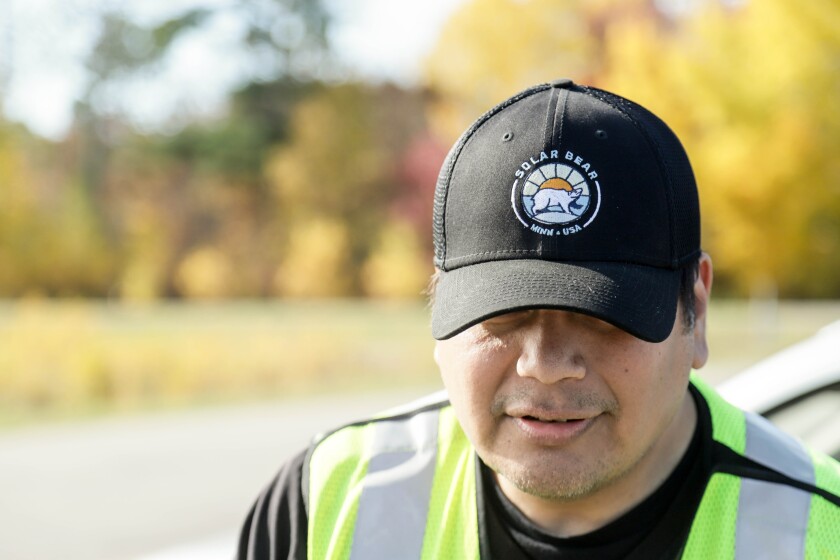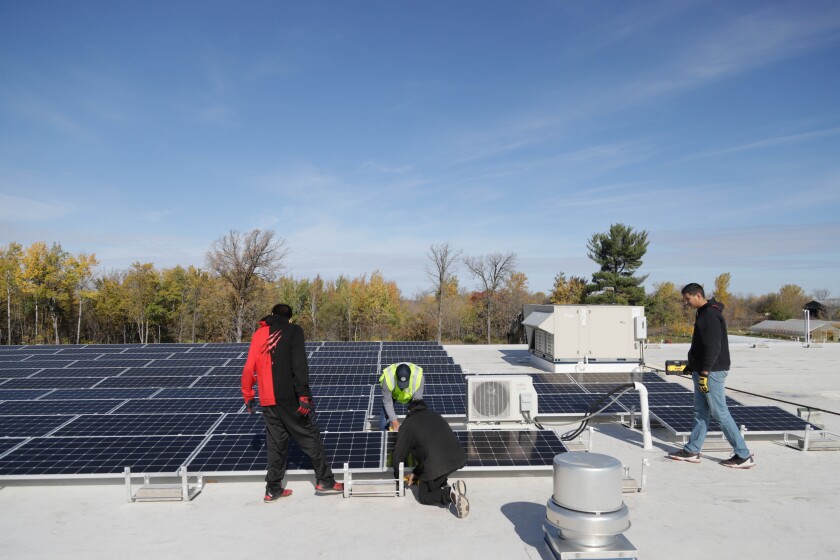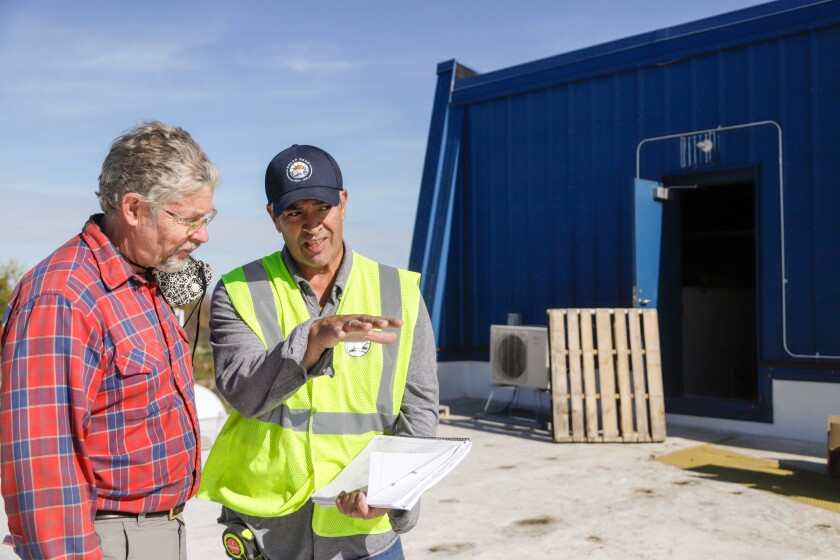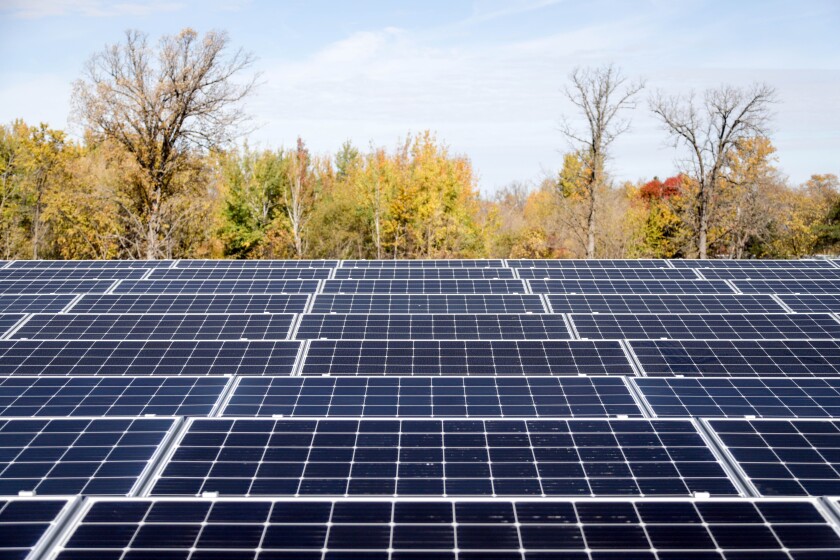REDBY, Minn. — When Bob Blake took on a paternal role for his nieces and nephew after the death of his brother, he suddenly felt an overwhelming desire to protect them from harm.
“This unconditional love came over me and I wanted to do something for them, I want to protect them and I want to help them. And I thought, well, maybe I can solve the climate crisis for them,” he said, and made a promise to do so.
His vow turned out to be quite the undertaking.
“I didn’t realize the climate crisis was this huge,” Blake said, reflecting with a laugh.
But now, 11 years after his brother’s death, he’s making headway.
ADVERTISEMENT
Originally from Red Lake, Minn., Blake now lives in Minneapolis and runs a solar energy company called Solar Bear , which is at the forefront of a groundbreaking project in Red Lake Nation.

The Red Lake Solar Project is in the early stages of a one-of-a-kind undertaking, with the ultimate goal of achieving energy sovereignty for the Red Lake Nation, while creating jobs and a more sustainable way of life for future generations. The project is rooted deeply in Ojibwe values with the desire to make decisions that will positively impact the world seven generations into the future.
Blake is at the heart of the project — he sees it as a spark for a movement he hopes will sweep the nation.
Looking out from his hybrid vehicle to the Oshkiimaajitahdah job site in early October, he said, “I didn’t realize it was going to turn into this. This is more than just a solar project. This is a revolution.”
'Someone’s got to do something'
Blake’s journey with solar began in 2009. He was working at Ameriprise Financial in the Twin Cities when he learned about investment opportunities within the clean energy realm.
He heard of the cost-effective nature of solar — panel prices have dropped significantly in recent years — and was hooked.
ADVERTISEMENT
“I felt like I had to do something, I had to take action, I didn’t just want to complain, or march — I did that. I protested,” he said. “But I thought, someone’s got to do something. And I just thought: Solar Bear.”
His next step was to write up a business plan.
“I thought what if I create a company, and we went out and did a bunch of solar projects?” he mused. “What if we did a solar project in Red Lake? What if we did solar projects in all tribal nations around the country? What if we did this revolution around solar?”
And thus, in 2017, Solar Bear — or “Giizis makwa” in Ojibwe, named after Blake’s clan, which he visualizes as a polar bear with sunglasses — was born.
Blake just needed a spark to bring it to life. And then he met Ralph Jacobson.
Pivoting toward power
In 2016, Ralph Jacobson, the founder of Impact Power Solutions, was hired by the tribe to conduct a feasibility study for solar capability in Red Lake Nation.
At the time, Blake was working for a solar company in Colorado, but he was excited by the potential he saw in the clean energy initiative being developed back home, and so decided to return to Minnesota.
When Jacobson hired him to conduct the installation of the arrays at the Red Lake Government Center, Blake took the chance to launch Solar Bear after years of careful planning.
ADVERTISEMENT
Jacobson is a veteran in the fight for clean energy — Blake referred to him as “the godfather of solar,” and sees him as a mentor.

Jacobson’s relationship with solar energy began in the 1970s when he was recovering from what he described as his first major failure in life: attempting to start an organic farm in Wisconsin.
“I went through a training course in 1979 and really latched onto solar as what I wanted to make my career in,” Jacobson said. “So, then it was just a matter of figuring out how to do that.”
Over the years, his company has become known for commercial installations and community solar gardens throughout the Midwest.
Jacobson noted that climate change was the talk of the town in both 2020 and 1979. “We haven’t moved the ball very far down the field,” he said.
He compares the climate crisis to a boat floating down the Niagara River. A few passengers on the boat are noticing the impending falls, but the other passengers are busy sightseeing in other directions. Jacobson worries they won’t try to stop the boat or turn it around until it’s teetering over the edge.
ADVERTISEMENT

A three-pronged plan
The ambitious Red Lake Solar Project was originally conceived in 2016 when the band began a concerted effort to diversify its economy and provide job opportunities to band members.
In his State of the Band address in March 2016, Red Lake Chairman Darrell Seki Sr. identified growing the band’s economy as a primary priority going forward.
“We as a nation have to diversify,” he said. “We need to create and develop our nation to be self-sufficient. By working together, we can accomplish this task to make our nation stronger.”
The project has three overarching goals involving installing solar panels on tribal buildings and eventually producing a 15 to 20-megawatt solar farm. The third phase of the project will be to develop a solar energy plant, and will culminate in the tribe buying out the existing arrays when the seven-year contract expires. The project so far has been funded via microloans and grants.
The first phase of the project began in 2017, and has been picking up steam ever since the first 70-kilowatt project on the Government Center in Red Lake was completed in 2018.
ADVERTISEMENT

The group is now in the midst of its second roof-top installation: a 240-kilowatt project on the Oshkiimaajitahdah workforce development center in Redby.
Seki explained during his 2019 State of the Band Address that tribal members were hired to install the system, and for most, it was their first on-the-job training experience of working with solar.
Think globally, act locally
Of all places, Blake thinks Red Lake is the perfect home for the start of a clean energy revolution. He said due to the unique structure of Red Lake as a sovereign nation, it can move faster in the development of a project like this.
“When you think about ‘what can a little community like Red Lake do to think globally, but act locally?’ This is it,” Blake said. “These tribes can move a lot faster than the outside world, because of the fact that they don’t have the donkey and the elephant fighting each other. They don’t have our political system that just doesn’t want to work together.”
Blake explained how Seki is a force for clean energy change.
“Our chairman, Darrell Seki, is like, ‘Let’s move forward, let’s think seven generations ahead instead of thinking four quarters,’” Blake explained. “What we’re going to do today is going to affect the seven generations ahead.”
Blake sees this as a fantastic economic opportunity for Red Lake. He hopes the project will grow into an economic powerhouse — no pun intended — for the tribe.
ADVERTISEMENT
He also hopes, if prosperous, the Red Lake project will serve as a model, something politicians and activists can point to as a success story.
“Our politicians need examples that we can point to and say, look what’s happening here,” he said. “Through qualitative and quantitative data we can show how successful this project is. We can measure it. If it’s successful then we can say, ‘You should do this in Bemidji, you should do this in Brainerd, you should do this in Uganda, you should do this in Clearbrook, you should do this everywhere,’ that’s how we save the planet.”
He also sees the project as a route toward equal footing with public utilities commissions statewide.

'A disruptive technology'
Blake said the choice for solar is clear.
Wind energy is expensive to produce, windmills take up lots of space. Hydro energy is more difficult with Minnesota winters. Geothermal energy is in the works in the region, but is still slow moving, he explained. Solar is quickly becoming the most cost-effective option.
“The thing is that the technology has brought down the price so low that it’s just logical to do this,” he said of solar. “Solar is just a disruptive technology. The cost of scale has come down dramatically.”
A decade ago, a solar panel would cost around $1,000 a piece. Now, Blake said individual panels cost around $200 including tariffs.
“China has brought down the cost of solar, it’s going to be on par with natural gas,” he said.

'New beginnings'
Up on the roof of the Oshkii building in Red Lake, four men carefully place solar panels into an array, as they will do another hundred times. Reflecting in the sun, a field of panels shines upward.

Nick Lopez was working at a restaurant in the Twin Cities when he got laid off due to COVID-19. Now he’s helping workforce development trainees to install panels.
Also on the roof on Oct. 8 are Rod “Sauce” McKenzie, Gary Cobenais and Rob Beaulieu III. The Red Lake Solar project is providing them and other band members with job training and employment opportunities.
Blake spoke with excitement about the workforce development program.
“I think what’s going to happen is this job training center is going to become a job training center not only for the tribe but for the upper Northland around renewable energy,” Blake said.
Oshkiimaajitahdah — which means “new beginnings” — holds special importance for Blake. His time there has come full circle, as years ago, Jerry Loud, the director of the center, arranged for him to go through a solar training program. Now he’s working on his roof.
“Jerry Loud gave me the opportunity to go through the solar training academy and now I’m putting solar on top of his building, it’s powerful,” he said. “It might inspire others in the community to follow their passions.”
Together, Blake and Jacobson have formed a nonprofit called Native Sun .
One of the nonprofit initiatives, “Just Solar Workforce” works with Solar Bear to challenge the prison-industrial complex by collaborating with the Minnesota Department of Corrections. The company trains formerly incarcerated people in solar installation so they have the skills to enter the solar industry after serving their time, ultimately in hopes of decreasing the chances a person would reoffend and be incarcerated again.
Another Native Sun project is creating a K-12 curriculum on climate change. In the pilot program in Red Lake they teach children about energy efficiency, renewable energy, recycling, and gardening.

Rumblings of a revolution
Blake can easily capture the attention of a room while speaking about his solar dreams. His words drip with passion, coming across like a motivational speaker. He has a vision.
On a local level, up to 20 buildings around Red Lake are on the short list to receive panel arrays — after the government center and Oshkiimaajitahdah, the Ponemah school is next on the list, with plans to be completed next spring. Following will likely be the other school buildings, community centers, casinos, the hospital, the justice center and the food production building.
On a grander scale, Blake sees a revolution brewing in Tribal Country.
He envisions a tribal utility as a driving force, a center point of the community, one that draws in revenue and employs many — the way casinos are for many tribal nations now.
Shuttered casinos have been feeling the aftershocks of COVID-19.
“Power projects are going to be what gaming was for the community,” Blake said. “Tribes will have to refocus.”
He also envisions a shift toward energy sovereignty for tribal nations.
“We always talk about tribal sovereignty, now I think the big thing is going to be energy sovereignty,” Blake said. He dreams of all 574 tribal nations in the United States signing on to the Paris Climate Agreement.
The Red Lake Solar Project and Blake’s company are already garnering international attention.
From potential funding from Google, a campaign panel with Joe Biden, to an interview with Rolling Stone , interest is flooding in from all over.
“It’s taken on a life of its own,” Blake said of Solar Bear. “It’s gotten me into Rolling Stone Magazine, it’s gotten me to do comments in the U.S. Senate, I’ve been asked to go to the United Nations. All these crazy things. Just from this stuff, right here.”
“I didn’t realize it was going to turn into this,” he added. “And then I thought to myself, maybe I will just solve the climate crisis for my nephew and nieces and I’ll make good on my promise.”
Multimedia reporter Hannah Olson can be reached at (507) 676-1101.











